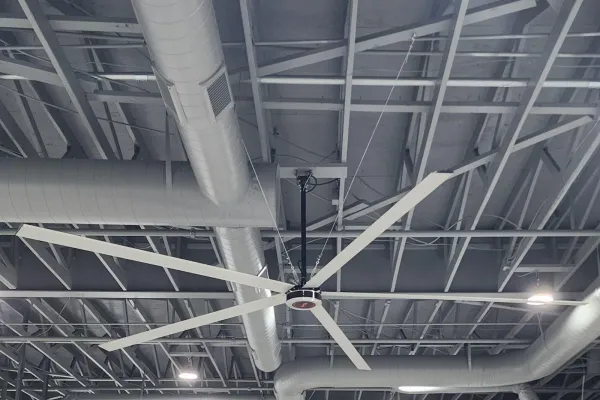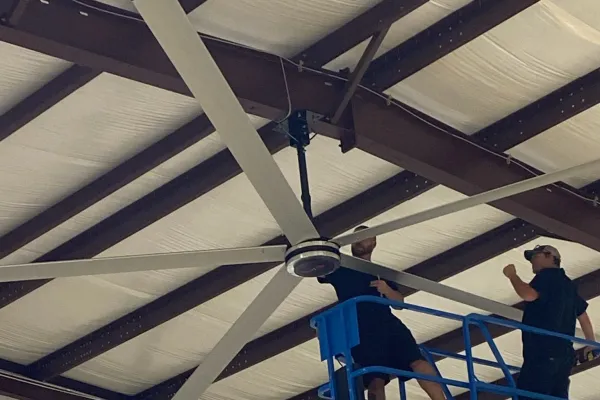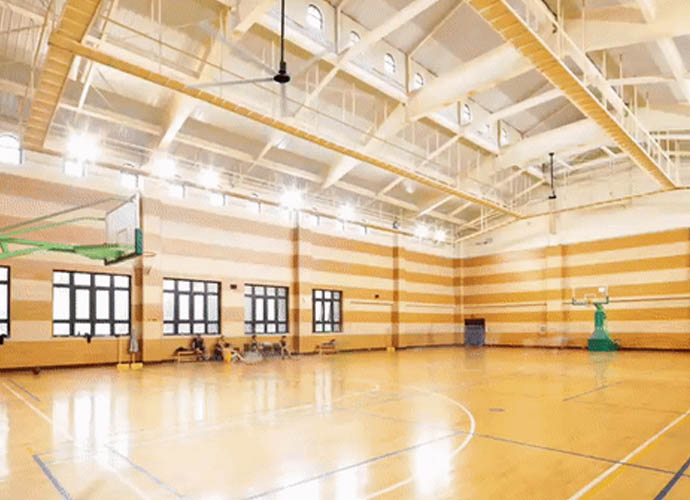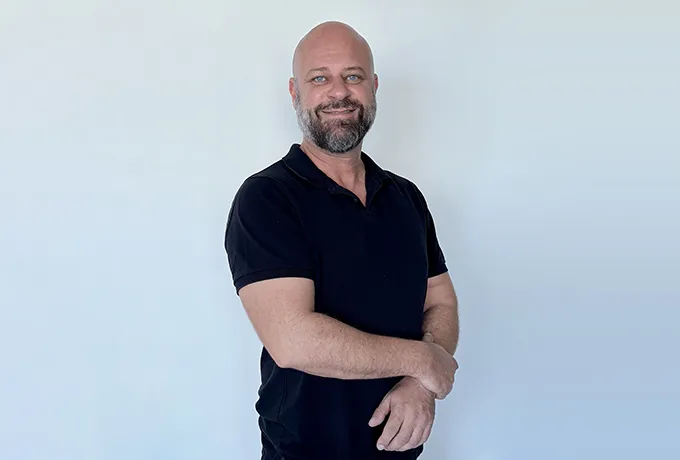Are you losing money every month on high energy bills? Do your workers complain about hot spots in your warehouse? Is the air in your large space stale and still?
Poor airflow in big spaces does more than make people sweat. It can drive up your energy costs by 30% or more! When hot air sits at the top of your building and cold air stays at the bottom, your HVAC system works extra hard—and your wallet feels the pain.
But it gets worse. Stagnant air breeds mold, makes workers less productive, and can even damage your products.
The good news? Large commercial ceiling fans offer a simple solution to these costly problems. Let’s explore how these mighty air movers can transform your space and save you thousands.
Large commercial ceiling fans are not like the small fans in your home. These are big, powerful machines made to move air in large spaces.
These fans have:
Unlike home fans, commercial fans must meet strict rules like AMCA 230 for airflow testing and UL 507 for safety. These rules make sure the fans work well and won’t cause harm.
Ventilatori HVLS (High-Volume Low-Speed) are the most common type. They move huge amounts of air while turning slowly and quietly. These fans can make a big difference in warehouses, gyms, factories, and other large spaces.

What Are Large Commercial Ceiling Fans
The math is simple: use fans to help your AC and heating work better. Case studies show warehouses can cut HVAC costs by up to 40%! One Ohio warehouse saved 38% on yearly energy costs after adding eight 24-foot fans.
Stale air is bad air. It holds moisture, dust, and smells. But wait—it gets worse. Poor air movement leads to mold growth, product damage, and health issues for your team.
Large ceiling fans keep air moving, which stops these problems before they start. Fresh air flows to all corners of your space, creating a healthier work setting.
Need to meet ASHRAE standards or earn Punti LEED? Large commercial fans help you check those boxes. Many models now come with energy-saving features that satisfy green building rules.
AC units have many parts that can break down. Commercial fans are simple machines with fewer things to fix. Most just need basic cleaning and a check-up once a year.
Hot, stuffy spaces make people tired and cranky. Studies link good airflow to better mood and more work done. In the Ohio warehouse example, worker output went up by 15% after fans were added!
Finding the right large commercial ceiling fan means looking at several key factors:
Match your fan size to your space. A fan that’s too small won’t move enough air. One that’s too big wastes energy and money.
Quick Guide:
Look for high Valori CFM that follow AMCA 230 standards. This tells you how much air the fan moves. More CFM means better air movement for each watt of power used.
Different spaces need different mounts:
Modern fans offer smart features that save even more energy:
Look for fans with:
Noise matters! Check the decibel level ratings. Good commercial fans should run at under 60 dB—about as loud as normal talking.
A good fan should come with a 5-10 year warranty. This shows the maker stands behind their product.
Will the fan work with your building’s power system? Can it be added without major changes to your space?
Top brands in the market include:
Never skip this step! Make sure your fans have Certificazione UL, Stella energetica ratings, and follow ASHRAE 90.1 standards.
| Marchio | Known For | Fascia di prezzo | Special Features |
|---|---|---|---|
| Grandi fan del culo | Market leader, industrial strength | $2,000-$5,000+ | IoT controls, highest CFM ratings |
| Cacciatore industriale | Good value, gym/retail models | $1,500-$3,000 | Quieter motors, easy install |
| Emerson | Energy-saving DC motors | $1,200-$2,800 | Low power use, slim designs |
| Tifosi di Vindus | Sustainable design, global reach | $1,400-$3,500 | Swedish engineering, green materials |
| Minka-Aire | Good looks with commercial power | $800-$2,000 | Style options, smaller spaces |
What makes Vindus different? Founded in 2019 in Spain, then adding a key hub in Qingdao, China in 2020, Vindus brings Swedish engineering to the HVLS fan world. Their fans focus on both power and planet-friendly design. With their US market entry in 2021, they’re fast becoming a top choice for spaces that want both performance and green values.

Guida all'installazione e alla manutenzione
The upfront cost of large commercial fans can seem high, but the savings add up fast!
Many power companies offer 10-30% rebates for energy-saving fans. These can cut your payback time from 4+ years to just 2-3 anni.
Let’s say you run a 40,000 sq ft warehouse:
After that first year, those savings go straight to your bottom line!
The numbers don’t lie. The U.S. industrial ceiling fan market hit $990,5 milioni in 2024 and keeps growing at nearly 6% each year. Why? Because these fans work!
Globally, the ceiling fan market will reach $16.18 billion by 2032. Asia leads with over 63% market share, but North America is catching up fast as more businesses discover the benefits.
The trend toward high volume low speed fans for commercial use shows no signs of slowing. As energy costs rise and green building becomes the norm, these fans make business sense.
Different work areas have unique needs:
Ventilatori HVLS per magazzini help keep goods safe and workers cool. Did you know 80% of U.S. logistics centers now use these fans?
Ventilatori da soffitto industriali per la produzione help control heat from machines and improve air quality.
Commercial ceiling fans for sports-centers keep athletes cool while staying whisper-quiet.
Ventilatori a soffitto ad alto volume per l'agricoltura help with livestock comfort and crop drying.

I migliori tifosi del centro sportivo
How many fans do I need for a 10,000 sq ft warehouse?
For good coverage, plan on one 20-24 ft fan per 2,500-3,000 sq ft. So a 10,000 sq ft space would need about 3-4 large fans.
Do large fans work with my current HVAC system?
Yes! Good fans help your HVAC work better by moving the air around. This means your system runs less while keeping comfort the same.
How long do industrial fans last vs. home fans?
A quality commercial fan should last 15-20 years with basic care. Home fans typically last 5-10 years.
Can these fans help in winter too?
Absolutely! In winter, these fans push warm air down from the ceiling, making heating more even and efficient.
Hot, stuffy spaces with high energy bills hurt your business every day. Poor air quality makes workers less happy and less productive. Uneven temperatures damage goods and create unsafe conditions.
The problem won’t fix itself. Each day you wait means more wasted energy dollars, unhappy workers, and missed savings.
Large commercial ceiling fans offer a proven solution that pays for itself quickly. With today’s energy-efficient models, smart controls, and professional installation options, there’s never been a better time to improve your airflow.
Ready to stop wasting energy and start saving money? The market has many good options, including innovative newcomers like Vindus Fans with their focus on sustainable design and global engineering expertise.
Take the first step: measure your space, check your energy bills, and contact a reputable provider of large commercial ceiling fans. Your wallet—and your workers—will thank you!

2024 Market Value
Growth Rate (2025-30)
Average HVAC Reduction

Ciao, sono Michael Danielsson, CEO di Vindus Fans, con oltre 15 anni di esperienza nel settore dell'ingegneria e della progettazione. Sono qui per condividere ciò che ho imparato. Se avete domande, non esitate a contattarmi in qualsiasi momento. Cresciamo insieme!